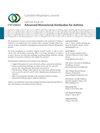Changes of Serum Adiponectin Level in Patients with Obstructive Sleep Apnea Hypopnea Syndrome and Its Relationship with Sleep Monitoring Indexes
IF 2.1
4区 医学
Q3 RESPIRATORY SYSTEM
引用次数: 0
Abstract
Objective. To observe the changes of serum adiponectin (AP) levels in patients with obstructive sleep apnea hypopnea syndrome (OSAHS) and explore the correlation between serum AP and polysomnography (PSG) parameters in patients with OSAHS. Methods. The data of subjects who underwent PSG at the hospital between January 2021 and December 2022 were collected retrospectively and divided into simple snoring group (AHI < 5 times/h, n = 45), mild OSAHS group (5 ≤ AHI < 15 times/h, n = 63), moderate OSAHS group (15 ≤ AHI ≤ 30 times/h, n = 52), and severe OSAHS group (AHI > 30 times/h, n = 60). The general data, PSG indices, and serological indices of the subjects were collected and compared between groups. Pearson correlation analysis and partial correlation analysis were employed to examine the correlation between serum AP level and PSG parameters. Ordered logistic regression was employed to analyze the risk factors influencing the severity of OSAHS. The predictive capability of the serum AP level in determining the occurrence of OSAHS was assessed using ROC. The serum AP levels of subjects with different subtypes of PSG indicators were compared. Results. In the simple snoring group, mild OSAHS group, moderate OSAHS group, and severe OSAHS group, there were statistically significant differences in microarousal count, MAI, AHI, times of blood oxygen decreased by ≥ 3%, L-SaO2, and TS90% among the 4 groups (). The level of serum AP was positively correlated with L-SaO2 and negatively correlated with the proportion of REM, microarousal count, MAI, AHI, times of blood oxygen decreased by ≥ 3%, TS90%, and LP (). High AHI was a risk factor affecting the severity of OSAHS (95% CI: 1.446–4.170). The AUC of serum AP level in diagnosing OSAHS was 0.906 (95% CI: 0.8601–0.9521), and when the Youden Index was 0.678, the sensitivity was 88.9%, and the specificity was 78.9% (). In the population with a high microarousal count, high AHI, and high times of blood oxygen decreased by ≥ 3% and high TS90%, the serum AP level was lower than that in the low-level population (). In the population with high L-SaO2, the serum AP level was higher than that in low-level population (). Conclusion. The level of serum AP decreased with the increase of the disease severity of patients with OSAHS and demonstrates a significant predictive capability for the occurrence of OSAHS. Monitoring the level of serum AP can effectively forecast the risk of OSAHS. Furthermore, alterations in serum AP levels are associated with both hypoxemia and a heightened frequency of arousal in patients with OSAHS.阻塞性睡眠呼吸暂停低通气综合征患者血清脂肪连接蛋白水平的变化及其与睡眠监测指标的关系
目的观察阻塞性睡眠呼吸暂停低通气综合征(OSAHS)患者血清脂肪连接蛋白(AP)水平的变化,探讨 OSAHS 患者血清 AP 与多导睡眠图(PSG)参数的相关性。研究方法回顾性收集2021年1月至2022年12月期间在该院接受PSG检查的受试者资料,分为单纯打鼾组(AHI < 5次/h,n = 45)、轻度OSAHS组(5 ≤ AHI < 15次/h,n = 63)、中度OSAHS组(15 ≤ AHI ≤ 30次/h,n = 52)和重度OSAHS组(AHI > 30次/h,n = 60)。收集受试者的一般数据、PSG 指数和血清学指数,并进行组间比较。采用皮尔逊相关分析和偏相关分析来研究血清 AP 水平与 PSG 参数之间的相关性。采用有序逻辑回归分析影响 OSAHS 严重程度的风险因素。使用 ROC 评估了血清 AP 水平对 OSAHS 发生的预测能力。比较了不同亚型 PSG 指标受试者的血清 AP 水平。结果显示在单纯打鼾组、轻度 OSAHS 组、中度 OSAHS 组和重度 OSAHS 组中,4 组的微鼾声计数、MAI、AHI、血氧下降≥3% 的次数、L-SaO2 和 TS90% 的差异有统计学意义()。血清 AP 水平与 L-SaO2 呈正相关,与快速动眼期比例、微动眼次数、MAI、AHI、血氧下降≥3% 的次数、TS90% 和 LP 呈负相关()。高 AHI 是影响 OSAHS 严重程度的危险因素(95% CI:1.446-4.170)。血清 AP 水平诊断 OSAHS 的 AUC 为 0.906(95% CI:0.8601-0.9521),当 Youden 指数为 0.678 时,敏感性为 88.9%,特异性为 78.9%()。在微动阙计数高、AHI高、血氧下降时间≥3%和TS90%高的人群中,血清AP水平低于低水平人群()。在高 L-SaO2 的人群中,血清 AP 水平高于低水平人群()。结论血清 AP 水平随着 OSAHS 患者疾病严重程度的增加而降低,对 OSAHS 的发生具有显著的预测能力。监测血清 AP 水平可有效预测 OSAHS 的风险。此外,血清 AP 水平的变化与 OSAHS 患者的低氧血症和唤醒频率增加有关。
本文章由计算机程序翻译,如有差异,请以英文原文为准。
求助全文
约1分钟内获得全文
求助全文
来源期刊

Canadian respiratory journal
医学-呼吸系统
CiteScore
4.20
自引率
0.00%
发文量
61
审稿时长
6-12 weeks
期刊介绍:
Canadian Respiratory Journal is a peer-reviewed, Open Access journal that aims to provide a multidisciplinary forum for research in all areas of respiratory medicine. The journal publishes original research articles, review articles, and clinical studies related to asthma, allergy, COPD, non-invasive ventilation, therapeutic intervention, lung cancer, airway and lung infections, as well as any other respiratory diseases.
 求助内容:
求助内容: 应助结果提醒方式:
应助结果提醒方式:


